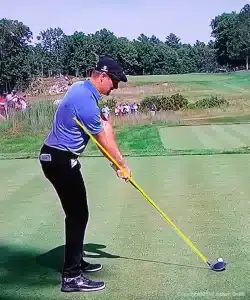Are you tired of losing strokes on the green? Do you find yourself constantly three-putting and can’t seem to break the cycle? Fret no more. Welcome to our comprehensive review of “How to Stop Three Putting”.
This guide will provide you with in-depth insights, tips, and strategies to help you lower your scores and improve your putting skills. We delve into the common mistakes golfers make, and how to rectify these issues, transforming you into a confident and competent putter.
Stay tuned as we reveal the secrets behind mastering the art of putting. This isn’t just a review; it’s a journey to the heart of your golf game. So, get ready to kiss those frustrating three putts goodbye, and say hello to lower scores and a more satisfying golf experience. Your journey to becoming a better putter starts here.
Some excellent tools to aid in the process of stopping three-putting. Read our reviews:
Eyeline Golf Putting Alignment Mirror Review
PuttOUT Devil Ball Face Angle Review
Understanding Three Putting
Three-putting, a common issue among golfers, refers to the situation where a golfer takes three strokes on the green to hole the ball. This can significantly increase your overall golf score, making it a crucial aspect to master in order to improve your game.
Consistency in putting is key to reducing three putts. This involves maintaining a steady rhythm and speed in your stroke. Also, understanding the green’s layout and being able to read its slope and grain can help you judge the direction and speed of your putt more accurately.
One of the leading causes of three-putting is poor distance control. This can be improved by practicing long putts. When you are able to control the distance of your putts, you can get the ball closer to the hole in fewer strokes.
Another important aspect is your aim. Practice your alignment to ensure that your putts are directed exactly where you intend them to go. This can be achieved by focusing on the target and aligning your body and clubface to it.
• A useful tip to avoid three-putting is to always aim for a ‘lag putt’. A lag putt is a long putt which is aimed not necessarily to go into the hole but to stop within a certain distance of it, usually within a 3-foot radius. This strategy can help you get closer to the hole in two strokes, reducing the chances of a three putt.
Remember, the key to stopping three-putting lies in consistent practice and understanding the factors that influence your putts. By focusing on these aspects, you can significantly improve your putting skills and lower your golf scores.
Why It’s Bad
Three-putting is detrimental to your golf game for several reasons. Firstly, it significantly increases your score. In golf, the goal is to complete the course with the fewest strokes possible, so each additional putt is a mark against you.
Another reason why three-putting is bad is because it indicates a lack of putting skills. This could be due to poor distance control, inaccurate aim, or a lack of understanding of the greens. A golfer who often three-putts may struggle with judging distances and speeds on the green, which can lead to frustration and a loss of confidence.
Three-putting can also indicate a lack of strategic planning. Good golfers know the importance of positioning their ball for an easier second putt. If you’re consistently three-putting, it could mean that you’re not thinking ahead and planning your shots effectively.
Here are some common causes of three-putting:
- Poor distance control: This can result from not practicing enough or not understanding how to adjust your stroke for different distances.
- Inaccurate aim: If you’re not aiming correctly, even a well-struck putt can miss the hole.
- Lack of understanding of the greens: Understanding how the ball will roll on different types of greens is crucial to avoid three-putting.
Three-putting is a clear sign that there are areas of your game that need improvement. By focusing on these areas, you can reduce your number of putts and improve your overall score. Remember, stop three-putting isn’t just about the mechanics, it’s about strategy and understanding the game.
How to Stop Three-Putting
Three-putting can be the bane of any golfer’s game, often resulting in unnecessary strokes and inflated scores. The key to stopping three-putting lies in a combination of improved green reading, precise distance control, and confident stroke execution.
Firstly, mastering green reading is essential. It requires understanding the slope and grain of the green, which can significantly influence the ball’s path. Spend some time studying the green before your putt, looking for any subtle changes in color or texture that may indicate a shift in the slope.
Secondly, distance control is crucial. This involves not only understanding how hard to strike the ball, but also being able to consistently execute that stroke. A common practice drill involves setting up tees at various distances and trying to stop the ball within a certain range of each tee.
Lastly, confidence in your stroke execution is a must. This can only be achieved through regular practice and repetition. The more comfortable you are with your putting stroke, the less likely you are to second-guess yourself and make errors on the green.
Stop three putting is not an overnight achievement, but a gradual improvement process. By focusing on these aspects, you can start to see a reduction in your number of putts per round, leading to lower scores and a more enjoyable golfing experience.
Type of Golfer It Affects
Three-putting is a common issue that affects golfers of all skill levels, from novice players to seasoned professionals. Particularly, it tends to plague those who struggle with distance control and accuracy on the greens. The inability to judge the pace of the greens accurately, coupled with poor alignment, often results in three-putting.
Beginners are especially susceptible to three-putting. They are still learning the nuances of the game and mastering the art of putting. The lack of experience and practice can lead to miscalculations and errors, resulting in additional strokes on the green.
Intermediate golfers, too, are not immune to three-putting. Despite having a solid understanding of the game, they can still struggle with consistency. The pressure of maintaining a lower handicap can lead to mental errors, causing them to misjudge their putts.
Even professional golfers can fall prey to three-putting, especially under tournament pressure. The challenge of managing nerves, coupled with the need for precision and accuracy, can sometimes lead to extra putts.
Lastly, senior golfers may also struggle with three-putting due to physical limitations. Age can affect strength and flexibility, which are crucial for a consistent and effective putting stroke.
In essence, three-putting is a universal challenge in golf. It underscores the importance of ongoing practice and refining one’s putting skills to stop three putting and improve overall performance on the greens.
Features of Good Putting
The art of good putting is a fundamental aspect of golf that can significantly reduce your chances of three-putting. The first feature to consider is Distance Control. This involves the ability to gauge the distance between the ball and the hole accurately. It is a skill that can only be perfected through consistent practice and keen observation of the putting green’s terrain.
Another critical feature is Aim. This is the ability to align your putter face to your desired target. Proper alignment is crucial in ensuring that the ball travels in the intended direction. Misalignment can often lead to three-putting, especially when the ball is far from the hole.
- Stroke Quality
Stroke quality is an essential feature of good putting. It refers to the smoothness and consistency of your stroke. A good stroke is one that is free from jerks or abrupt changes in speed. It should be a fluid motion that propels the ball straight and at the correct speed.
Confidence is another critical feature of good putting. It is the mental aspect of the game that can make or break your performance. Confidence can be built through practice, mental conditioning, and positive reinforcement. A confident golfer is less likely to three-putt as they are more likely to trust their instincts and make decisive strokes.
Lastly, the feature of Reading Greens is a skill that involves understanding the terrain of the green and how it will affect the ball’s path. This skill is crucial to avoid three-putting as it allows the golfer to anticipate the ball’s movement and adjust their stroke accordingly.
Remember, good putting is a combination of physical and mental skills. It requires practice, patience, and a deep understanding of the game’s intricacies.
Specs Needed for Better Putting
In the world of golf, mastering the art of putting is crucial. One of the biggest challenges golfers face is the dreaded three-putt. To stop three putting, understanding the specifications of your putter is paramount.
The length of your putter can significantly influence your putting performance. A putter that is too long or too short can lead to misalignment and poor control. It’s crucial to find the right length that matches your stance and swing style.
The weight of your putter also plays a significant role. A heavier putter provides more stability, reducing the chances of the clubface opening or closing prematurely. However, it may also slow down your stroke speed.
The loft of your putter is another key specification. A loft that’s too high or too low can lead to bouncing or skidding, which affects the roll of the ball. The ideal loft helps the ball start rolling smoothly on the green.
- The grip of your putter is another crucial spec. A thicker grip can help reduce wrist action, leading to a smoother and more consistent stroke.
Lastly, the design of your putter can affect your putting. A blade putter is generally suited for fast greens and straight strokes, while a mallet putter is more forgiving and better for slower greens and arced strokes.
By understanding these specifications and how they impact your putting, you can make informed decisions about your putter choice and setup, ultimately helping you to stop three putting.
Pros & Cons of Different Putting Techniques
The world of golf is full of diverse putting techniques, each carrying its own set of advantages and disadvantages. A popular technique is the conventional putting stroke, which is often the first technique learned by beginners. Its simplicity and straightforwardness make it easy to adopt, but it may not yield the best results when it comes to long-range putts.
On the other hand, the cross-handed putting or left-hand-low technique, is favored by many golfers aiming to stop three putting. This method provides better control over the putter’s face, improving the accuracy of the putt. However, it can feel awkward for some golfers and may require more practice to master.
The claw grip is another alternative putting technique. It is designed to reduce wrist action and improve stroke consistency. While this technique can help in maintaining a square putter face, it can be difficult to control distance, especially on fast greens.
- Arm-lock putting is a technique gaining popularity among professional golfers. By locking the putter shaft against the left forearm, golfers can stabilize their stroke, reducing the chance of three-putting. However, this method requires a specific type of putter and can be difficult to adapt to.
The belly putter technique, once a popular choice, has been largely abandoned due to rule changes. It offered great stability but was criticized for reducing the skill level required in putting.
Remember, the best putting technique is one that suits your personal style and comfort. Experiment with different methods, practice consistently, and you’ll be on your way to stop three putting in no time.
Player Comments & Conclusion
The quest to Stop Three Putting has been a consistent endeavor for golf enthusiasts. Many players, both seasoned and novices, have expressed their struggles with this aspect of the game. A common sentiment is the need for a more consistent putting stroke, emphasizing the necessity of mastering the art of distance control.
One player commented on how focusing on the speed of the putt significantly improved his game. He mentioned that by prioritizing the speed over the line, he was able to reduce three putts. Another player highlighted the importance of practice. She stated that repetitive practice of different putting lengths helped her to gain confidence and precision, thus reducing the likelihood of three putting.
Several golfers also emphasized the role of understanding green reading. They pointed out that knowing how to read the greens and predict the ball’s path can be the difference between a two-putt and a dreaded three-putt.
Finally, the role of a good putter cannot be underestimated. Some players noted that investing in a putter that fits their style and comfort significantly improved their putting performance.
- Consistent putting stroke
- Speed of the putt
- Practice
- Understanding green reading
- Good putter
These insights from players underscore the complexity of putting and the various elements that need to be mastered to successfully Stop Three Putting.
Wrapping Up: The Final Stroke on ‘Stop Three Putting’
In conclusion, we’ve taken a deep dive into the world of golf, specifically focusing on the concept of ‘Stop Three Putting’. We began by understanding what three putting is and why it is detrimental to your golf game. We then explored various methods on how to stop three putting, revealing that it is a concern for golfers of all types, from beginners to professionals.
We also highlighted the features of good putting and the specifications required for better putting. The pros and cons of different putting techniques were examined, providing a balanced view of the options available.
We also appreciated the candid player comments which gave us a real-world perspective on this topic. The insights shared by these players are invaluable and provide a practical understanding of the subject matter.
The importance of the keyword ‘Stop Three Putting’ cannot be overstated. It is a key aspect of the game that can significantly affect a player’s score and overall performance. We encourage you to apply the tips and techniques discussed in this post to improve your putting game.
Read our reviews of some excellent tools to aid in the process of stopping three-putting:
Eyeline Golf Putting Alignment Mirror Review
PuttOUT Devil Ball Face Angle Review
Looking ahead, advancements in golf technology and training methods may further influence the techniques and strategies for putting. However, the fundamental principles of good putting will remain the same. Remember, practice makes perfect, so keep working on your putting skills. Good luck on the green!




